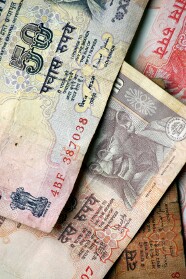The Indian rupee strengthened today after the Indian central bank kept its key interest rate unchanged in an effort to support the nation’s economy and the currency, but outlook for the rupee remained bearish.
The Reserve Bank of India maintained its benchmark repo rate at 8.5 percent, a move anticipated by market analysts. The cash reserve ratio for banks was reduced from 6.0 per cent to 5.5 percent. Economists considered this decision as monetary easing and as an attempt to bolster purchases of local assets by foreign investors. That was a necessary step as “growth is decelerating”, according the statement by Bank’s Governor Duvvuri Subbarao after the policy meeting. He explained that the economic slowdown is “the combined impact of several factors: the uncertain global environment, the cumulative impact of past monetary policy tightening and domestic policy uncertainties”.
The Indian government and the RBI announced last year measures to support the nation’s currency. It sounds reasonable as the rupee fell 16 percent in 2011, being the worst performer among the 10 most-traded currencies of Asia. Analysts don’t believe that this year will be much better for the currency. Ilan Solot, emerging-markets currency strategist at Brown Brothers Harriman said:
Still, we think that sentiment remains fragile and frontloading rate cuts will only make the RBIâs life harder should it have to step in to defend the rupee once again. We donât think the underlying fundamentals have shifted that much in 2012, so we remain skeptical that the rupeeâs outperformance can continue.
USD/INR fell from 50.0825 to 50.0300 and EUR/INR went down from 65.1889 to 65.1480 as of 6:59 GMT today.
If you have any questions, comments or opinions regarding the Indian Rupee,
feel free to post them using the commentary form below.
